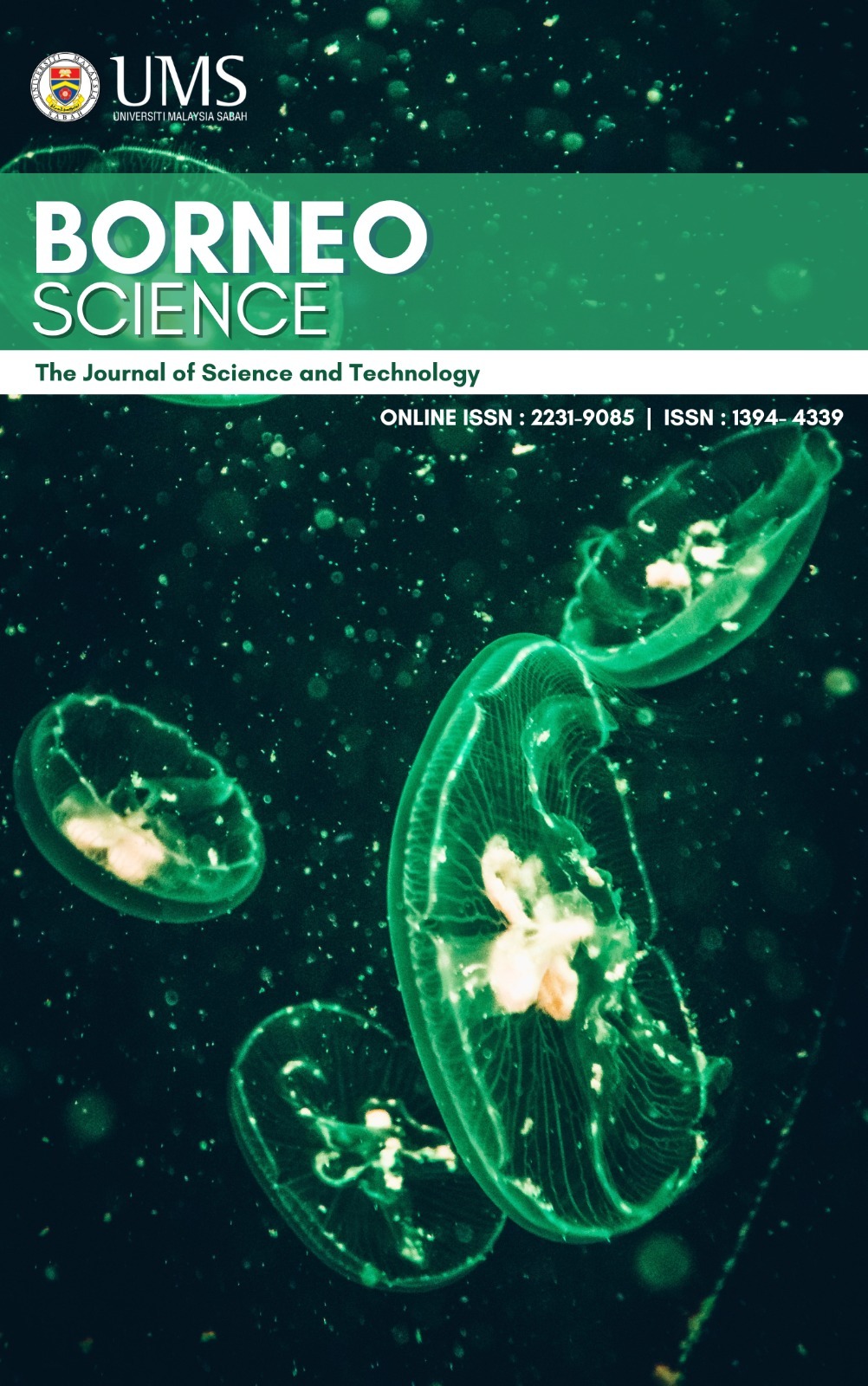Characterization of Different Metal Oxide Promoted Alumina Catalyst
DOI:
https://doi.org/10.51200/bsj.v38i2.4412Keywords:
Biofuel, metal oxide promoted alumina catalyst, wet incipient impregnation methodAbstract
In this study, different metal oxide alumina promoted catalysts were prepared and characterized. All the catalysts (CaO/Al2O3, CuO/Al2O3, FeO/Al2O3, MnO/Al2O3, NiO/Al2O3 and ZnO/Al2O3) were prepared using the incipient wetness impregnation method followed by drying and calcination. The characterization of all six samples of catalysts was done to determine the surface morphology, porosity, functional group, thermal stability, metal content and particle size distribution. Scanning electron microscope (SEM) analysis of samples showed that there were pores on the surface of the alumina. Mercury intrusion porosimetry (MIP) showed that copper oxide alumina promoted (CuO/Al2O3) had the high porosity which is 36.77 m2/g followed by zinc oxide (ZnO/Al2O3), calcium oxide (CaO/Al2O3) nickel oxide (NiO/Al2O3) manganese oxide (MnO/Al2O3) and ferric oxide alumina promoted (FeO/Al2O3) catalysts. Fourier transform infrared spectroscopy (FTIR) analysis showed the presence of by-product existed in all catalysts. Atomic absorption spectroscopy (AAS) analysis showed the presence of Cu, Fe and Zn in the CuO/Al2O3, FeO/Al2O3 and ZnO/Al2O3, while Ca was absent in CaO/Al2O3. Besides, through thermo-gravimetric analyzer (TGA) and differential thermal analysis (DTA), all the catalysts showed a slight decrease in weight which can be considered as a stable catalyst. The particle size distribution analysis using the Zetasizer showed the particle size mean based on the intensity of CaO/Al2O3, CuO/Al2O3, FeO/Al2O3, MnO/Al2O3, NiO/Al2O3 and ZnO/Al2O3 were 2305 nm, 5560 nm, 5560 nm, 1281 nm, 1281 nm and 3580 nm, respectively.
References
Aliyu, A. S., Ramli, A. T.,Saleh, M. A. 2014. Environmental impact assessment of a new nuclear power plant (NPP) based on atmospheric dispersion modeling. Stochastic Environmental Research and Risk Assessment 28 (7): 1897-1911.
Bakar, W. A.W. A., Othman, M.Y., Ali, R. Yong, C.K., Toemen, S. 2009. The investigation of active sites on nickel oxide based catalysts towards the in-situ reactions of methanation and desulfurization. Modern Applied Science 3(2): 35-43.
Bridgwater, A.V. 2012. Review of fast pyrolysis of biomass and product upgrading. Biomass and Bioenergy 38: 68-94.
Buitrago-Sierra, R., Ruiz-Martínez, J., Serrano-Ruiz, J.C., Rodríguez-Reinoso, F., A. Sepúlveda-Escribano A. 2012. Ethanol Steam Reforming on Ni/Al2O3 Catalysts: Effect of the Addition of Zn and Pt. Journal ofColloid and Interface Science 383(1): 148-154.
Dorado, M.P. Ballesteros, E. Arnal,. J. M. Gómez, J. López, F.J. 2003. Exhaust emissions from a diesel engine fueled with transesterified waste olive oil. Fuel 82(11): 311- 1315.
Gan, P. Y., Li, Z. D. 2008. An econometric study on long-term energy outlook and the implications of renewable energy utilization in Malaysia. Energy Policy 36(2):890- 899.
Haber, J., Block, J. H., Delmon, B. 1995. Manual of methods and procedures for catalyst characterization. Pure and Applied Chemistry 67: 1257-1306.
Hagen, J. 2006. Industrial catalysis: A practical approach. Wiley-VCH Verlag GmbH & Co. , 1-14.
Hashim H, Ho, W. S. 2011. Renewable energy policies and initiatives for a sustainable energy future in Malaysia. Renewable and Sustainable Energy Reviews 15(9):4780- 4787.
Huang, H., Young, N., Williams, B.P. , Taylor, S.H., Hutchings, G. 2005. COS hydrolysis using zinc-promoted alumina catalysts. Catalysis Letters 104(1): 17-21.Kiss, E., Ratkovic, S., Vujicic, D., Boskovic, G. 2012. Accelerated polymorphous transformations of alumina induced by copper ions impede spinal formation. Indian Journal of Chemistry 51(A): 1669-1676.
Li, G. 2005. FT-IR studies of zeolite materials: characterization and environmental applications. The University of Iowa’s Institutional Repository, Ph.D thesis.
McKendry, P. 2002. Energy production from biomass (part 1): overview of biomass. Bioresource Technology 83: 37-46
Nascimento, J. C., Sousa, J. F., Rojas, L.O. A., Fontes, F.A.O. 2011. Synthesis and characterization of CuCl2 /SiO2 catalyst for the oxychlorination of methane. Brazilian Journal of Petroleum and Gas 5(2): 55-63.
Ookawa. M. 2012. Synthesis and characterization of Fe-Imogolite as an oxidation catalyst. InTech, 239-258.
Pua, F., Fang, Z. Zakaria, S. Z., Guo, F. Chin-Hua, C. 2011. Direct production of biodiesel from high-acid value Jatropha oil with solid acid catalyst derived from lignin. Biotechnology for Biofuels 4: 56.
Rosal, R., Gonzalo, M.S., Rodríguez, A., García-Calvo E. 2010. Catalytic ozonation of fenofibric acid over alumina-supported manganese oxide. Journal of Hazardous Materials 183(1-3), 271–278.
Zabeti , M., Daud , W.M.A.W., Aroua M.K. 2010. Biodiesel production using aluminasupported calcium oxide: an optimization study. Fuel Processing Technology 91(2) 243–248.
Zabeti , M., Daud , W.M.A.W., Aroua M.K. 2009. Optimization of the activity of cao/al2o3 catalyst for biodiesel production using response surface methodology. Applied Catalysis A: General 366 (1) 154-159.






